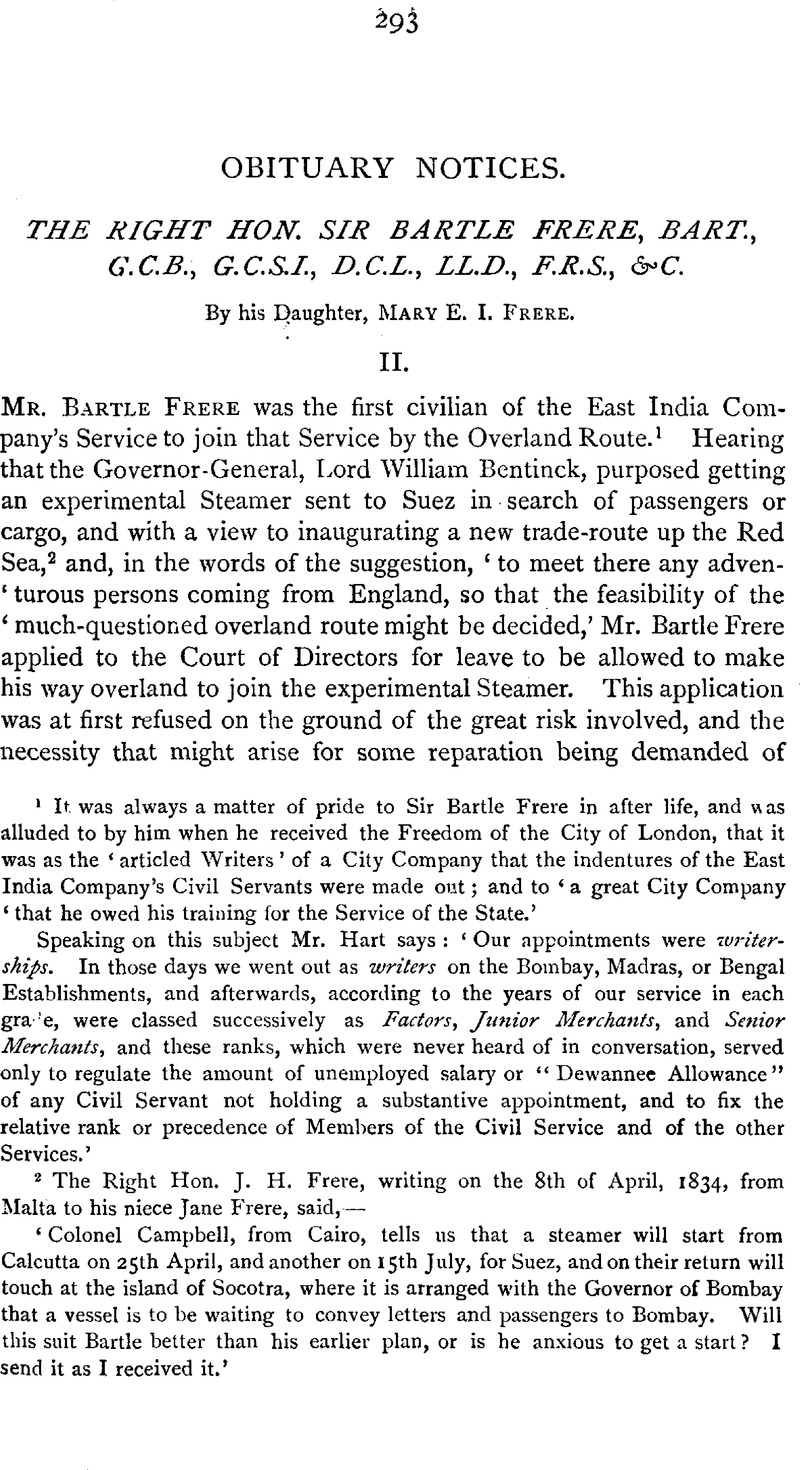No CrossRef data available.

page 293 note 1 It was always a matter of pride to Sir Bartle Frere in after life, and was alluded to by him when he received the Freedom of the City of London, that it was as the ‘articled Writers’ of a City Company that the indentures of the East India Company's Civil Servants were made out; and to 'a great City Company ‘that he owed his training for the Service of the State.’
Speaking on this subject Mr. Hart says: ‘Our appointments were writerships. In those days we went out as writers on the Bombay, Madras, or Bengal Establishments, and afterwards, according to the years of our service in each grade, were classed successively as Factors, Junior Merchants, and Senior Merchants, and these ranks, which were never heard of in conversation, served only to regulate the amount of unemployed salary or “Dewannee Allowance” of any Civil Servant not holding a substantive appointment, and to fix the relative rank or precedence of Members of the Civil Service and of the other Services.’
page 293 note 2 The Right Hon. J. H. Frere, writing on the 8th of April, 1834, from Malta to his niece Jane Frere, said,—
‘Colonel Campbell, from Cairo, tells us that a steamer will start from Calcutta on 25th April, and another on 15th July, for Suez, and on their return will touch at the island of Socotra, where it is arranged with the Governor of Bombay that a vessel is to be waiting to convey letters and passengers to Bombay. Will this suit Bartle better than his earlier plan, or is he anxious to get a start? I send it as I received it.’
page 294 note 1 Vide Appendix II.
page 295 note 1 Zizyphus Fujuba, a tropical tree.
page 296 note 1 The Rev. H. Ellacombe, M.A., then Vicar of Bitton, in whose Sunday school he used to teach the children before leaving England.
page 296 note 2 Lieut. Fred. Horn, H.M.'s 20th Foot (at that time stationed in the Bombay Presidency), now Lieut. General Sir F. Horn, K.C.B.; Ensign James Chambré, H.M.'s 20th Foot, now Captain Chambré (retired); Lieut. John Patrickson, Madras Artillery; Mr. Quandborough, a midshipman of the Indian Navy (died about 1854, retired Lieut. Indian Navy). I am indebted to Captain Chambré and General Sir Frederick Horn for most of the details of the account of the voyage to India. My Father's journal ofthe journey to Kossier, being entrusted to his Maltese servant to post to his family, was never received by them. We possess a book of the sketches taken by my Father in 1834, which begins with Bitton Church and Lanes, and gives the epitome of his journey to India in the marginal notes to the sketches. These sketches, forty in number, done in chalk, pen and ink, sepia, or water colours, comprise views from on board ship, going down the Mediterranean, at Malta, in Egypt, and going up the Nile. Among them is a sketch of Cleopatra's Needle, of which he mentions that ‘The lower hieroglyphics are nearly obliterated, apparently by relic hunters, those on the south face by (as I was told) the constant abrasion of the sand blown against them.’ There are sketches of the Pyramids from within and without; of the mummy Catacombs at Esiout [Lycopolis]; the Memnonium at Thebes; the great gate and colossal ruins at Luxor, with the wonderful bas-reliefs on the walls, with which, he says, he should have been more struck if he had not previously seen Denon's plate of them, ‘which is rather a restoration than a faithful picture—at least, as they stand now;’ of Biban El Moolook, the Valley of the Tombs of the Kings at Thebes; the temple of Isis at Denderah; Nambo; various picturesque native groups; and of the ‘Cangia’ in which he was sailing.